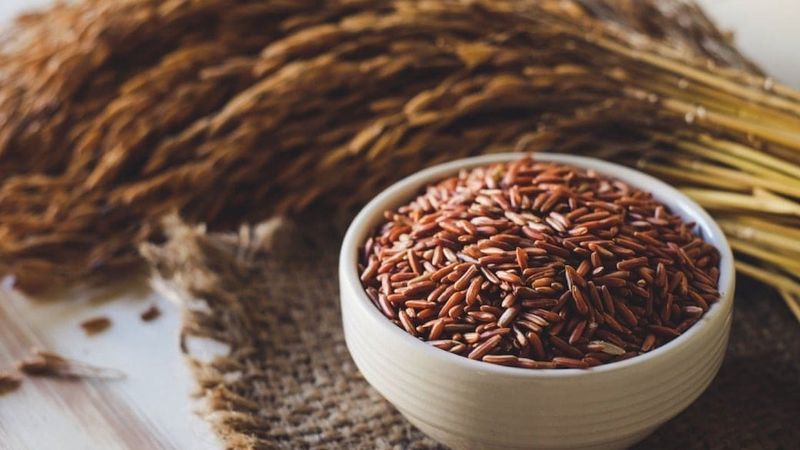

Our Review Process
Our articles undergo extensive medical review by board-certified practitioners to confirm that all factual inferences with respect to medical conditions, symptoms, treatments, and protocols are legitimate, canonical, and adhere to current guidelines and the latest discoveries. Read more.
Our Editorial Team
Shifa Fatima, MSc.
Author
Dr. Apoorva T, MHM.
MEDICAL ADVISOR
Brown Rice For Diabetes - Benefits & Risks
is brown rice good for diabetics? Brown rice for diabetic patients which is healthy, contains whole grain and rich in nutrients. Compared to white rice, brown rice has a low glycemic index (GI) and more complex carbohydrates, leading to slow digestion. Hence, it does not cause spikes in blood glucose levels; therefore, brown rice can be eaten in diabetes. However, caution should be taken to eat in moderate quantities as it is still a rich carbohydrate source. Also know about pp blood sugar
Nutritional Benefits
You should replace regular rice with brown rice since the latter is more nutritious. Learn more about its nutritional profile shared below:
Nutritional Value of 1 Cup of Brown Rice
| Fat | 1.96 grams |
|---|---|
| Protein | 5.54 grams |
| Carbs | 51.7 grams |
| Fiber | 3.23 grams |
| Potassium | 174 mg |
| Starch | 50.1 grams |
| Magnesium | 78.8 mg |
| Phosphorous | 208 mg |
| Iron | 0.82 mg |
| Sodium | 9.75 mg |
| Copper | 0.2 mg |
| Calcium | 19.5 mg |
| Folate | 7.8 mcg |
With such a robust nutritional profile, brown rice helps in muscle tonicity, wound healing, nerve conduction, etc. The GI of brown rice is 68, making it fall in the medium GI category. So you can continue enjoying it in moderation without worrying much about the blood sugar spikes.
Table of Contents
Does brown rice affect blood sugar?
Brown rice is a good source of nutrients such as vitamins, minerals, etc. Adding brown rice to the diet is beneficial in diabetes as it is absorbed slowly in the blood and avoids spikes of glucose; hence, it helps regulate or reduce sugar levels. Eating brown rice has been associated with a reduced spread of diabetes. However, caution should be taken not to over-consume and monitor your portion size.
General Health Benefits
Being a rich source of vitamins, minerals, fibres, and antioxidants, brown rice helps overall well-being. Brown rice contains flavonoids- plant-based antioxidants that help fight various inflammatory disorders and free radicals. Antioxidants help reduce the risk of various disorders such as heart conditions, Alzheimer's disease, cancer, etc. Brown rice, being a whole grain, is high in fibre content and aids in digestion. High fibre content is also helpful to reduce the risk of various chronic digestive disorders such as Crohn's disease, inflammatory bowel disease, etc. It can also aid in weight loss. Know about diabetes treatment.
Health benefits of brown rice for diabetes
Brown rice may not be as good as white rice in terms of taste, but it sure exceeds white rice in terms of health benefits. If you are contemplating your decision to replace white rice with brown rice, the following benefits of brown rice will help you make the right decision.
- Helps in Your Weight Loss Journey
Brown rice is high in fiber compared to white rice. When you eat more fiber-dense food, you feel full for a longer period. If you replace your white rice with brown rice, you can reduce your belly fat too. However, weight loss takes time, and you will notice eventual improvement with time.
- Aids Digestion
Food items with high fiber composition can help optimize your digestive system. The fiber in brown rice helps regulate intestinal movements, keeping your bowel movements regular and smooth. If you include brown rice in your daily diet, you can also see improvement in constipation-related problems. Brown rice has also been proven beneficial in reducing colitis symptoms.
- Reduces the Risk of Neurodegenerative Diseases
Regular brown rice consumption can lower your risk of neurodegenerative disorders and cognitive dysfunction. Rich in fiber, brown rice lowers bad cholesterol levels known to increase neurodegenerative diseases. It also helps treat other diseases like Alzheimer’s or Parkinson’s, and can assist cure depression, anxiety, and stress.
- Controls Blood Sugar Levels
One of the best and effective ways to maintain healthy blood glucose levels is by consuming low to medium-GI food items. The Glycemic index (GI) measures how a particular food item affects your blood sugar. The lower the GI, the lower the chances of it resulting in glucose spikes. Brown rice has a medium GI of 68, so people with diabetes can eat it without worrying. Brown rice contains essential polyphenols, phytic acid, and fiber that help slow the sugar-release process, preventing blood sugar spikes.
- Other Health Benefits
Brown rice is very rich in magnesium and calcium, making it helpful in maintaining good bone health. If you have osteoporosis, arthritis, or other bone problems, including brown rice in your diet can help. It even helps people recover from postpartum depression, fatigue, disturbed mood, etc. You must maintain a healthy diet for an extended period to see any visible results.
If you want to start eating healthy and control your blood sugar levels, including brown rice can be an excellent decision. Talk to your nutritionist to decide on an ideal dosage based on your health condition, and begin your healthy eating journey

May protect against Type 2 diabetes
While multiple studies establish the benefits of brown rice in people with diabetes, it has also been found to reduce the risk of developing type 2 diabetes. The risk of type 2 diabetes in adults consuming 2 servings/week was reduced significantly. Interestingly, replacing _ cup of white rice with brown rice was associated with a 16% reduction in the risk of developing type 2 diabetes.
These findings are probably explained by the high fibre content in brown rice. Another explanation is that brown rice is a rich source of magnesium � a mineral nutrient associated with reduced risk of diabetes development.
Glycemic Index of Brown Rice
Brown rice has a GI of 68. Hence, it falls in the category of foods with medium GI (range 56-69). It is lesser than 73- the GI of white rice that falls in the high GI category. Hence, brown rice is a better alternative for diabetics than white rice.
Portion sizes and diet quality
The portion size of any meal has to be as per your blood glucose control. You should regularly monitor your blood glucose levels and know the impact of various foods on glucose control.
You can include brown rice in your diet for daily consumption; however, you should consume it in moderation. Although brown rice has a medium GI and if you eat _ cup brown rice daily, still you will be consuming approximately 26 g of carbohydrates. The quantity will primarily depend on your blood glucose control and your meal size, the inclusion of other whole grains, fruits, vegetables, nuts, etc.
How to cook brown rice
Being inexpensive, brown rice is a staple food in many parts of the world. There are a variety of dishes that can be cooked using brown rice, such as curries, salads, soups, vegetable burgers, grain bowls, puddings, etc. In addition, brown rice can be cooked in various diabetic-friendly preparations such as:
- Brown rice puddings.
- Spring roll salads
- Stir-fry Brown rice with salmon and vegetables
- Brown rice with chicken sausage and pinto beans
- Brown rice garnished with fruits and vegetables
Can Diabetics Eat Brown Rice Every Day?
While brown rice is healthier and more nutritious than white rice, it must be consumed in moderation. If you have diabetes, your primary focus should be limiting your daily carb intake. Your blood glucose levels will be influenced if you exceed your carbs limit. There is no fixed carbs recommendation for everyone, and individuals must decide the optimal intake based on how their blood sugar levels respond to carbs and their daily blood sugar goal.
For example, if your nutritionist has asked you to maintain a limit of 30 grams of carbs on every meal, you should not have more than 100 grams of brown rice since it contains 26 grams of carbs. Besides monitoring the carbs intake, you should plan a balanced meal that gives you the right amount of carbs, lean protein, fiber, and healthy fat. This way, you can easily manage your portions without losing any nutritional benefits.
Also read about how to prevent diabetes
Bottomline
Brown rice is a rich source of fibre, vitamins, minerals, antioxidants and a great addition to your diabetic diet plan. So, the answer to the question can diabetic patients eat brown rice is yes. However, brown rice should be eaten in moderation to avoid carbohydrate overload, which will eventually be converted to glucose, even if it is slow. In addition to that, it is crucial to monitor your blood glucose levels, exercise regularly, and stay physically active.
FAQs
Can brown rice raise blood sugar?
Many dieticians and experts suggest brown rice for diabetic patients. Brown rice retains the nutrient-filled germ and bran layers of the grain. The outer hull part is removed which also gets rid of the starch. Even though brown rice is higher in different nutrients as compared to white rice, it is still high in carbs. Being high in carbs means that brown rice would also have a high glycemic index, especially if the portion is not controlled. So, brown rice is good for diabetic patients if it is consumed infrequently and not in significantly large quantities.
Which is better for diabetics: brown rice or white rice?
Several studies have been conducted to understand the efficacy of using brown rice over white rice among people with diabetes. Certain significant results prove that using brown rice is better in terms of the overall management and even prevention of the onset of diabetes. White rice is known to have a higher glycemic index as opposed to brown rice. Eating two or more servings of brown rice per week is also associated with an 11% lower risk of the onset of type 2 diabetes. Brown rice does not increase the sugar levels as fast and as much as white rice. Therefore, the question, is brown rice good for blood sugar would be answered - yes
What are the disadvantages of eating brown rice?
Brown rice contains arsenic. The long-term consumption of brown rice can increase the risk of the development of illnesses such as cancer, and heart disease. This should not be that big of a concern if the consumption of brown rice is moderate. At times, overconsumption of brown rice can also prevent the body from absorbing good nutrients in the other food items. Additionally, certain side effects reported are – bloating, nasal congestion, cramps, lethargy, diarrhea, etc.
Is Rice Good for Diabetics?
Yes, brown rice is good for diabetics. We cannot say the same for white rice because of its high GI. If you have diabetes, we’d suggest eating rice in moderation to prevent any blood sugar spikes. Brown rice takes time to digest, so sugar is released in low amounts over time. It prevents instances of blood spikes, helping people control their glucose levels.
Which Rice Has a Low Glycemic Index?
Brown rice has a low glycemic index, making it a healthy rice option for people with diabetes. It has a GI of 68, considered medium on the Glycemic Index scale. Eating brown rice can help maintain healthy blood glucose levels; just be mindful of consuming it in moderation.
Glycemic Index of White Vs. Brown Rice
White rice has a GI of 72, while brown rice has a GI of 68. While the difference might seem small, it dramatically affects your blood sugar levels. Brown rice has a medium GI, meaning it has little to moderate impact on your glucose levels. But since white rice is qualified as a high GI food item, it has a higher potential to influence your blood sugar levels.
Is Long Grain Rice Good for Diabetics?
Yes, long-grain rice is good for diabetics if consumed in moderation. You also have to decide which rice type to include in your diabetes-friendly diet because white rice releases sugar faster in your bloodstream than brown rice. It has a huge impact on your blood glucose levels. If you want to eat long grain rice, have the brown long grain rise over white rice.
Does Brown Rice Increase Blood Sugar?
Yes, brown rice can increase blood sugar if you eat it in large amounts. Although it has a low GI, overconsumption can lead to blood glucose spikes. The best way to prevent blood sugar from rising is by keeping your carbohydrate intake in check. Talk to your nutritionist regarding the ideal daily carbohydrate requirement based on your health condition, and adjust the consumption accordingly.
References
- https://www.healthline.com/nutrition/brown-rice-for-diabetes
Disclaimer
This website's content is provided only for educational reasons and is not meant to be a replacement for professional medical advice. Due to individual differences, the reader should contact their physician to decide whether the material is applicable to their case.








